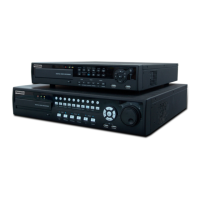
Do you have a question about the ProVisual H Series and is the answer not in the manual?
Covers servicing, damage, replacement parts, and safety checks.
Details field installation, battery use, operating temperature, and air flow.
Addresses mechanical loading, circuit overloading, grounding, and warranty void conditions.
Check included items after unpacking the DVR main body and accessories.
Refer servicing to a supplier or distributor with qualified service personnel if problems arise.
Illustrates the system connection for ProVisual DVR models.
Details how to install hard disks and DVD-RW drives into DVR SATA ports.
Explains various video, audio, network, and alarm connections for DVR models.
Describes the functions of keys and status LEDs on the DVR front panel.
Explains how to select camera channels on various DVR models.
Illustrates the front panel layout for different ProVisual DVR series.
Details how to use the remote controller, including multi-DVR setup.
Explains mouse button functions and their equivalents to front panel keys.
Provides a legend for icons displayed on the DVR screen.
Describes the process for logging into and out of the DVR setup menu.
Covers system info, ID, language, account management, logs, and shutdown.
Manages OSD, De-Interlace, Transparency, Main Monitor, and Spot Monitor configurations.
Manages Network, Camera/PTZ, Audio, and Alarm configurations.
Manages recording modes, schedule, event recording, and motion detection.
Configures event linking for alarms, motion, video loss, and system events.
Covers initial display, view formats, digital zoom, freeze, and pan/tilt control.
Covers searching recorded video by date/time, calendar, or event.
Allows playback of recorded video with various control functions.
Lists hardware and software requirements for installing the CMS program.
Provides step-by-step instructions for installing the CMS software.
Describes how to launch and log into the CMS application after installation.
Displays the Watch mode screen after CMS login, showing connected DVRs.
Configures CMS (PC) and network settings for connecting to DVRs.
Covers network connection, live display, watch modes, and screen adjustments.
Controls the Pan/Tilt of DVR cameras.
Monitors the operating status of DVR components like cameras and HDDs.
Allows changing DVR menu setup through CMS.
Provides access to search functions for DVR video, CMS stored video, and event data.
Searches recorded DVR video remotely or CMS stored data locally by date/time.
Searches recorded event data from the DVR.
Controls playback using buttons for fast forward/backward, play, stop, and navigation.
Executes the archive file viewer program.
Loads and executes the E-Map program for visualizing site layouts.
Checks integrity of video files for corruption or modification.
Estimates data size and recording days based on DVR settings.
Converts archived EXE files to AVI format using specified codecs.
Describes requirements and steps for installing and logging into the CMS Web Client.
Covers features of the live video display, including split modes and PTZ controls.
Details the playback screen features for searching and viewing recorded video.
Covers installation, site registration, connection, search, PTZ, and uninstallation for iPhone.
Covers installation, site registration, connection, search, PTZ, and uninstallation for Android.
Covers installation, site registration, connection, PTZ, and uninstallation for Blackberry.
Covers installation, site registration, connection, PTZ, and uninstallation for Symbian.
Covers installation, site configuration, connection, and uninstall for Windows Mobile.